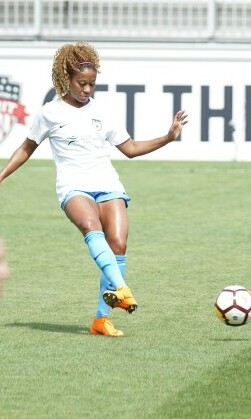 Soccer, a sport celebrated worldwide, is as much about strategy as it is about skill. To appreciate its complexities, a fundamental understanding of player positions is key. Picture the soccer field as a stage where each player has a specific role that contributes to the team’s performance.
Soccer, a sport celebrated worldwide, is as much about strategy as it is about skill. To appreciate its complexities, a fundamental understanding of player positions is key. Picture the soccer field as a stage where each player has a specific role that contributes to the team’s performance.
Typically, teams are organized in formations described by three or four numbers, such as 4-4-2 or 3-5-2. These numbers correspond to the arrangement of players across the field, starting with defenders and ending with attackers. The goalkeeper, who is the team’s last line of defense, is not included in this numbering system as they are a constant presence behind the outfield players.
Each position carries distinct responsibilities. Defenders focus on preventing the opponent from scoring, midfielders on controlling the game’s tempo and linking play, and forwards on creating and finishing scoring opportunities. However, soccer is fluid; these roles can adapt in response to the changing dynamics of the game.
For beginners, grasping the basics of player positions marks the first step in understanding soccer’s tactical depth. It lays the groundwork for analyzing formations and player movements, which can elevate a spectator’s enjoyment and a player’s performance.
Let’s move forward by zooming in on the defensive line. It’s here where we’ll see how key tactics and player responsibilities mold a team’s backbone and how defenders contribute to both protection and the initiation of an attack.
Decoding the Defense: Roles of Defenders in Soccer
A soccer team’s defense is its foundation, the bedrock that can determine the outcome of the match. Defenders have the primary job of stopping the opposition from scoring, but their role is multifaceted and demands a mix of tactical awareness, physical prowess, and technical skill. Let’s explore the different types of defenders and their roles on the field.
Central defenders, or center-backs, are the anchors of the defense. Positioned in the middle, they often handle the most physical part of the game, going head-to-head with opposing forwards. These players need to excel in aerial duels, be strong in their tackles, and also be able to read the game, intercepting passes and initiating plays from the back.
Flanking the center-backs, full-backs occupy the wide defensive spots. Traditionally, their main task was to thwart incoming attacks from the wings and block crosses. However, modern full-backs are also expected to support their own wingers, providing a key overlap option in offense and delivering crosses themselves. The emergence of wing-backs has taken this even further, as they operate in a more advanced position and are vital in both defending wide areas and propelling forward moves.
The role of the sweeper or libero has seen a transformation in contemporary soccer. Once commonplace, this position entails a player who roams freely behind the line of central defenders, cleaning up through balls and acting as a last line of defense before the goalkeeper. Though less prevalent today, the essence of this role lives on in players who command the defense, often stepping in to cut out threats and distribute the ball with composure.
Defensive strength lies not just in individual skill but in the coordinated effort of all defenders. Understanding when to press an attacker, when to fall back, and how to maintain a solid line is key. The synergy between defenders is paramount; it creates a united front that is tough for opponents to penetrate and is crucial for a team’s success.
The Heart of the Game: Midfielders’ Impact on Soccer Dynamics
The effectiveness of a soccer team often hinges on the performance of its midfielders. These players serve as the pivotal link between defense and offense, orchestrating the flow of the game with their vision, ball control, and distribution. Central midfielders are particularly vital, as they regularly engage in both defensive duties and attacking support. They must showcase a high level of stamina and positional awareness to influence play across the entirety of the pitch.
Wingers and wide midfielders stretch the play horizontally, bringing valuable width to a team’s offensive arsenal. They’re typically tasked with accelerating past defenders, delivering crosses into the penalty area, and occasionally cutting inside to unleash shots at goal. Their speed and dribbling ability can disturb the opposition’s defensive structure and create openings for center-forwards to exploit.
Advanced midfielders, or attacking midfielders, provide the creative spark that can unlock tight-knit defenses. They operate in the spaces between the opposition’s midfield and defensive lines, often positioning themselves to receive the ball with enough time and space to turn and attack directly. Their role also includes threading precise through balls, taking on defenders, and adding to the team’s goal tally either through goals or assists.
The harmony within the midfield unit is crucial. Teams often field a combination of defensive-minded players tasked with intercepting passes and protecting the back line, alongside their more attack-focused counterparts. This blend ensures that the team can remain solid when defending, yet dynamic and unpredictable when in possession, maintaining the equilibrium necessary for sustained dominance in matches.
The Art of Scoring: Unpacking Striker Positions in Soccer
In soccer, strikers are the names on the marquee; they capture the imagination with their flair for goal-scoring. They’re positioned at the forefront, often shouldering the burden of turning a game on its head. I’ll highlight the nuance between the roles within the striker positions and how they blend individual prowess with team strategy.
The classic center-forward, or number 9, is your quintessential goal-scorer. They lead the line, use physical presence to hold up play, and have an eye for goal. But their role is more than scoring; it’s about creating space and opportunities for teammates, making them pivotal in any formation.
Then there’s the second striker, a hybrid player adept at finding gaps behind the main striker. They bridge the midfield and attacking line, pulling defenses out of shape with their intelligent movement. Their ability to both score and assist adds a layer of unpredictability to the attack.
On the flanks, wingers or wide forwards employ their speed and dribbling to outpace defenders. They serve up crosses, cut in to shoot, and stretch the opponents’ formation — a triple threat that can dismantle even the most organized defenses.
Understanding how these striker roles interact with each other and the rest of the team lays the groundwork for appreciating the game’s complexity. Remember, soccer is a symphony, and strikers hit the high notes. Their performances can define a match, and when they link up harmoniously, they’re virtually unstoppable.
In conclusion, strikers may grab the headlines, but as I’ve shown, they’re part of a larger tactical system. Each role, from the robust center-forward to the agile winger, is crafted to exploit specific weaknesses in the opposition. For beginners looking to grasp the subtleties of the game, starting with striker positions is a wise move. The next time you watch a match, notice the strikers’ movements, the space they create, and the chances they generate. It’s a brilliant way to see the game through a new lens and deepen your appreciation for the beautiful game.
